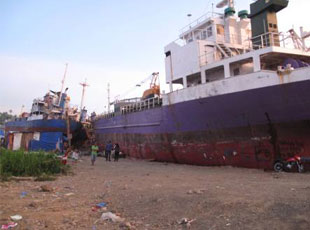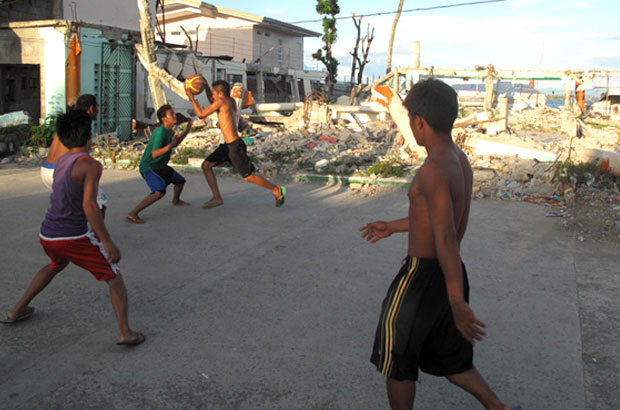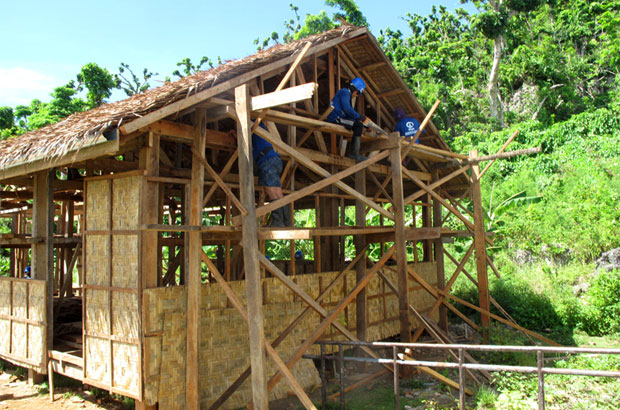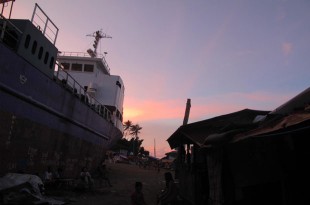The last time I flew into Tacloban was in the back of a British military Hercules (I wrote about it here). Boxes of high energy biscuits lined the runway and lifesaving relief supplies were unloaded from military planes from all over the world by burly marines.
Six months after Typhoon Haiyan struck the Philippines, flying into Tacloban is a somewhat different experience; on the packed Philippines Airlines flight I'm amicably jostled by Filipinos laden with brand new electrical appliances and boxes of Krispy Kremes for friends and family they're visiting. Back in November I was part of the response team deployed after the typhoon. I was back again in January (read here) and this time round I'm part of a team reviewing UK support and the difference it has made in the last 6 months.

Last November, the drive from the airport showed a flattened city: piles of rubble chest-high either side of the road, cars and minibuses hurled into the roofs of buildings by the force of the storm surge and thousands of families sheltering in the city’s convention centre. Shells of buildings still line the road but now much of the debris has been cleared, with the felled coconut trees being turned into lumber and sold by opportunistic vendors to rebuild homes, while in between the rubble kids play basketball on makeshift courts. The ships that were hurled through the middle of residential areas by the force of the waves are still there, but people have continued to build around or quite literally inside them. Hotels have started to re-open, electricity is back and the once-ubiquitous some-time strangled cat sound of Filipino karaoke is returning to colour the evenings.

Clearing the rubble is of course the easy part. Six months after, the trauma of what happened can start to surface and, while basic needs might be being met, many find themselves without a livelihood. Taxi drivers, hotel and restaurant owners who have been able to start business back up might make a decent trade from the aid workers who have descended on the town, but a drive through what was the industrial area in Tacloban shows a different story. What was the Coca Cola factory is now a roofless wreck with mounds of broken glass and empty crates and the recently completed Nissan factory is just a shell.
Further out from Tacloban areas like Guiuan have received less attention and livelihoods may take years to recover. But walking along the once flattened sea-front, the smell of the fish from the market reaches you along with the sound of hammer and nails, people rebuilding their homes in sometimes patchwork but ingenious ways. Throughout the city are signs with the words ‘Tindog (rise up) Tacloban’.

Everyone has their own story about the Typhoon – sometimes it's the first thing people tell you, sometime piece by piece a fragmented picture emerges. Families who evacuated, those who stayed behind to look after the livestock, people who had tied themselves to trees, clambered to the top of buildings, or found themselves trapped in evacuation centres. The common themes: an unbelievable fortitude and resilience, a determination to rebuild. Watch this brilliant video and you'll get an idea...
One evening I started talking to a Filipino, who was living in Singapore when the typhoon hit. He rushed back to look after his ill parents, and 6 months later he is still here. All the town’s bars had been wrecked, and he thought that like him, people might need a beer and a place to meet and talk with others at the end of a stressful day. Never having been a businessman before, he bought a trailer and created the ‘Moveable Bar’ that could be hooked to a generator and towed across the town. He’d never spent more than 2 weeks in Tacloban previously – too boring he said – now 6 months in, along with the bar he’s about to open a hostel. He says that he wants to make Tacloban a place people want to visit.

He tells me a story about the typhoon from his neighbours. After the first wave swept through the town they saw an elderly married couple clamber up onto the roof of the house opposite. They roped themselves together, declared their eternal love and started passionately kissing, determined that even if the second wave took them away, they would share their last moments together. The neighbours saw this happening from the opposite balcony, watching aghast. Miraculously, they all somehow managed to survive the typhoon. As it turns out, however, although the couple were married, it wasn’t to each other. They had spent years hiding their desires, and then the typhoon came and tore everything asunder. My friend tells me he doesn’t know what happens in the story after this. I’m not sure anyone does exactly.
Keep in touch. Sign up for email updates from this blog, or follow DFID Response on Twitter.

Recent Comments